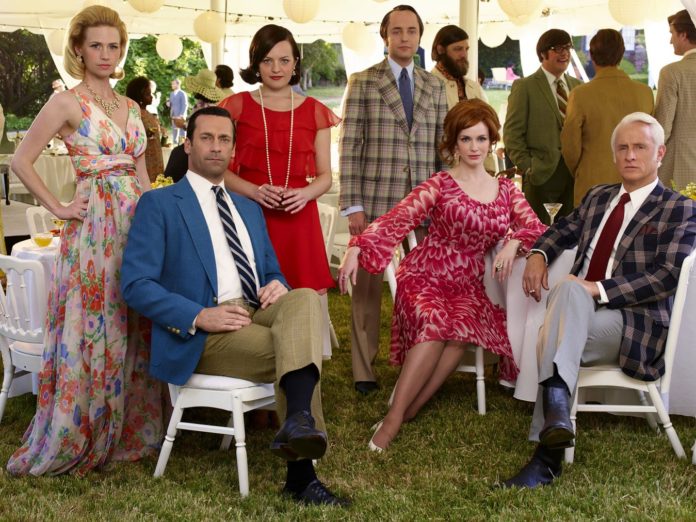I’m going to miss “Mad Men.” The long- running AMC drama, which airs its final episode this weekend, gathered a fiercely loyal fan base, of which I am happy to have been a part. The show’s unsurpassed examination of the mores of the 1950s and ’60s was often imitated (think ABC’s disastrous “Pan Am”), but never equaled. Creator Matthew Weiner’s relentless attention to the minutiae of the period was often a joy to behold all by itself. But his true triumph was the ability to weave the copiously researched details of cars, hair, clothes, music, even books and magazines into an intricate and compelling narrative.
“Mad Men” at its best focused on the twin worlds of advertising and post-World-War-II professional life. Don Draper, the show’s antihero, gave us a perfect if often cringe-inducing combination of talent, duplicity, ambition, self-reliance, duplicity, drive, a relentless focus of the work itself, and did I mention duplicity?
To watch Don build a tiny idea into an advertising campaign was enthralling, especially in the early seasons, when the soap opera had not yet overwhelmed the show’s originality. In the best episode, “The Suitcase,” we see Don trying to come up with an approach to selling consumers on the durability and strength of the Samsonite luggage brand. The creative team offers some truly terrible ideas. Frustrated, and with his personal life in no clear state, Don gets angry at copywriter Peggy Olsen, who complains that he has just won a Clio for an advertising spot based on an idea she gave him, and never even said thank you. “That’s what the money’s for!” he shouts — “Mad Men’s” most memorable line. They quarrel, they make up, they go off to a bar to listen to the Clay-Liston fight on the radio. Don falls asleep drunk in his office with his head in Peggy’s lap, and the next morning he spots the iconic photograph of a triumphant Clay standing over Liston in the newspaper and at once knows what the Samsonite campaign will be.
Perfect drama.
As an ethicist and law professor, I mined the show’s portrayal of the business world for examples I could use in the classroom. Last spring, a hypothetical lawsuit based on “Mad Men” formed an integral part of my final exam in an Evidence class.
Some critics thought the show was cynical in its casual deconstruction of the values of what some consider a sturdier era. But Weiner’s take on the era was more nuanced. There were moments when “Mad Men” seemed entranced by the traditions it was supposedly subverting.
I have previously defended the show against the charge of anti-conservative bias. The most mature and reflective character, Henry Francis, was a Republican whose his steadfastness and commitment to his beliefs were presented entirely without irony. It’s unfortunate that once Henry played the key role for which he was introduced — rescuing Betty Draper from her philandering and lying husband — the writers never could figure out what else to do with him.
Each of the three most fully drawn female characters had to deal with an unwanted pregnancy. None had an abortion. Joan Holloway came closest, but changed her mind at the last minute. Peggy up gave her child for adoption. Betty decided to take one last shot at making the family work. One could of course put this down to the laws and values of the era. But women did have abortions then, illegally, and when Joan got as far as the doctor’s office, viewers thought Weiner was going to explore that dramatic territory. But, as always, he fooled us.
The show dealt openly, if painfully, with homosexuality. The fate of Sal Romano, a wonderful character who wanted only to live as he felt he had to, always struck me as perhaps “Mad Men’s” greatest tragedy.
Integrating the events of the day was a Weiner forte. The confident predictions of a Nixon victory in 1960, the panic during the Cuban missile crisis, the way the world seemed to stand still after John Kennedy’s assassination, the moon landing– all of these were worked deftly into the narrative.
True, the show didn’t handle every bit of history well. I have noted that although the characters have their run-ins with the counterculture, the true radicals — the disciples of Marcuse and Fanon — never appear. The biggest political issue of the era was civil rights, but the riots of 1965, 1967 and 1968 remain on “Mad Men’s” periphery, and the writers never did figure out how to integrate either the movement or prominent black characters into the show. (Paul Kinsey, who had a black girlfriend and went south to join the marchers, had little to do thereafter.)
This final season has been valedictory, and we’ve watched various characters march off to various endings. Megan, Don’s second wife, was never well integrated into the show. She vanished into Hollywood, a millionaire by divorce, but wasn’t murdered by the Manson family, as lots of fans expected and not a few seemed to hope. Pete Campbell, the scheming and selfish young man on the make, was someone many fans loved to hate — which perhaps explains why the mischievous Weiner has evidently scheduled him for a happy ending. Joan, too, left happily — if, once more, painfully. Peggy seems destined for triumph. Don’s fate we’ll learn on Sunday night.
The critics are right that “Mad Men” was stronger in the early seasons, when it won four straight Emmys. In the later years, there was too much soap opera, and the writers visited the blow-up-the-firm well twice too often. Yet even at its weakest, the show was among the very best dramas in TV history. As I turn now to spending my Sunday nights waiting through blood and gore and betrayal for winter to bring the White Walkers to the wall, I’ll continue to marvel at and miss Weiner’s remarkable creation.
— Stephen L. Carter is a Bloomberg View columnist and a law professor at Yale.






